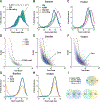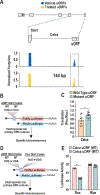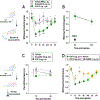A peptide encoded within a 5' untranslated region promotes pain sensitization in mice
- PMID: 33449506
- PMCID: PMC8119312
- DOI: 10.1097/j.pain.0000000000002191
A peptide encoded within a 5' untranslated region promotes pain sensitization in mice
Abstract
Translational regulation permeates neuronal function. Nociceptors are sensory neurons responsible for the detection of harmful stimuli. Changes in their activity, termed plasticity, are intimately linked to the persistence of pain. Although inhibitors of protein synthesis robustly attenuate pain-associated behavior, the underlying targets that support plasticity are largely unknown. Here, we examine the contribution of protein synthesis in regions of RNA annotated as noncoding. Based on analyses of previously reported ribosome profiling data, we provide evidence for widespread translation in noncoding transcripts and regulatory regions of mRNAs. We identify an increase in ribosome occupancy in the 5' untranslated regions of the calcitonin gene-related peptide (CGRP/Calca). We validate the existence of an upstream open reading frame (uORF) using a series of reporter assays. Fusion of the uORF to a luciferase reporter revealed active translation in dorsal root ganglion neurons after nucleofection. Injection of the peptide corresponding to the calcitonin gene-related peptide-encoded uORF resulted in pain-associated behavioral responses in vivo and nociceptor sensitization in vitro. An inhibitor of heterotrimeric G protein signaling blocks both effects. Collectively, the data suggest pervasive translation in regions of the transcriptome annotated as noncoding in dorsal root ganglion neurons and identify a specific uORF-encoded peptide that promotes pain sensitization through GPCR signaling.
Copyright © 2021 International Association for the Study of Pain.
Conflict of interest statement
Declaration interests
The authors declare no competing interests.
Figures





Similar articles
-
Regulation of fungal gene expression via short open reading frames in the mRNA 5'untranslated region.Mol Microbiol. 2003 Aug;49(4):859-67. doi: 10.1046/j.1365-2958.2003.03622.x. Mol Microbiol. 2003. PMID: 12890013 Review.
-
uORF-Tools-Workflow for the determination of translation-regulatory upstream open reading frames.PLoS One. 2019 Sep 12;14(9):e0222459. doi: 10.1371/journal.pone.0222459. eCollection 2019. PLoS One. 2019. PMID: 31513641 Free PMC article.
-
Translational buffering by ribosome stalling in upstream open reading frames.PLoS Genet. 2022 Oct 31;18(10):e1010460. doi: 10.1371/journal.pgen.1010460. eCollection 2022 Oct. PLoS Genet. 2022. PMID: 36315596 Free PMC article.
-
Global analysis of boron-induced ribosome stalling reveals its effects on translation termination and unique regulation by AUG-stops in Arabidopsis shoots.Plant J. 2021 Jun;106(5):1455-1467. doi: 10.1111/tpj.15248. Epub 2021 Apr 26. Plant J. 2021. PMID: 33772920
-
Natural uORF variation in plants.Trends Plant Sci. 2024 Mar;29(3):290-302. doi: 10.1016/j.tplants.2023.07.005. Epub 2023 Aug 26. Trends Plant Sci. 2024. PMID: 37640640 Review.
Cited by
-
Small but mighty: the rise of microprotein biology in neuroscience.Front Mol Neurosci. 2024 May 14;17:1386219. doi: 10.3389/fnmol.2024.1386219. eCollection 2024. Front Mol Neurosci. 2024. PMID: 38807924 Free PMC article.
-
Inhibition of Nonsense-Mediated Decay Induces Nociceptive Sensitization through Activation of the Integrated Stress Response.J Neurosci. 2023 Apr 19;43(16):2921-2933. doi: 10.1523/JNEUROSCI.1604-22.2023. Epub 2023 Mar 9. J Neurosci. 2023. PMID: 36894318 Free PMC article.
-
Ion Mobility Coupled to a Time-of-Flight Mass Analyzer Combined With Fragment Intensity Predictions Improves Identification of Classical Bioactive Peptides and Small Open Reading Frame-Encoded Peptides.Front Cell Dev Biol. 2021 Sep 17;9:720570. doi: 10.3389/fcell.2021.720570. eCollection 2021. Front Cell Dev Biol. 2021. PMID: 34604223 Free PMC article.
-
A role for translational regulation by S6 kinase and a downstream target in inflammatory pain.Br J Pharmacol. 2021 Dec;178(23):4675-4690. doi: 10.1111/bph.15646. Epub 2021 Sep 12. Br J Pharmacol. 2021. PMID: 34355805 Free PMC article.
-
Translation and natural selection of micropeptides from long non-canonical RNAs.Nat Commun. 2022 Oct 31;13(1):6515. doi: 10.1038/s41467-022-34094-y. Nat Commun. 2022. PMID: 36316320 Free PMC article.
References
Publication types
MeSH terms
Substances
Grants and funding
LinkOut - more resources
Full Text Sources
Other Literature Sources
Medical
Research Materials

